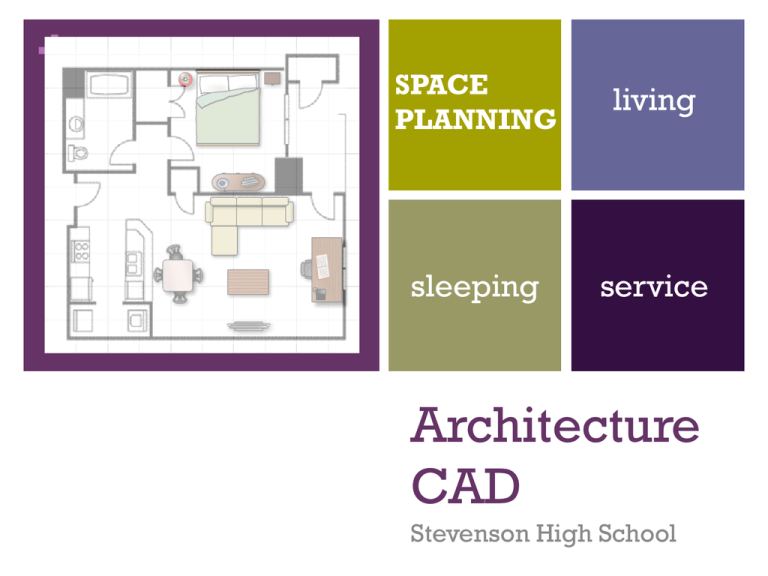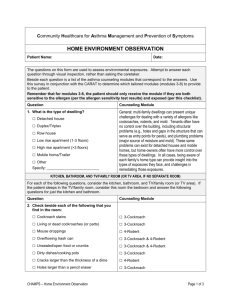Architecture CAD - Stevenson High School
advertisement

+ SPACE PLANNING living sleeping service Architecture CAD Stevenson High School + 3 BASIC AREAS OF RESIDENCE Sleeping Area Where the family resides to sleep and rest. Living Area Where the family relaxes, dines, entertains guests, and gathers. Service Area Where food is prepared, clothes are laundered, goods are stored, the car is parked, and house equipment is stored. + 3 BASIC AREAS OF RESIDENCE + SPACE PLANNING sleeping Sleeping Area: Where the family sleeps and rests. + SLEEPING AREA The sleeping area comprises about onethird of the home. Includes bedrooms, bathrooms, dressing rooms, and nurseries. Normally home. Should located in a quiet area of the have a south or southwest orientation. + SLEEPING AREA - BEDROOMS + SLEEPING AREA - BEDROOMS Houses are frequently categorized by the number of bedrooms. Family size usually determines the number of bedrooms Bedrooms bathroom should be located close to a + SLEEPING AREA - BEDROOMS Functional Bedroom Layout + SLEEPING AREA - BATHROOMS + SLEEPING AREA - BATHROOMS Bathroom’s generally contain a sink, toilet, & tub/shower. A bathroom with a sink & toilet is considered a half bath. Bathrooms with a sink, toilet, tub and/or shower is considered a full bath + SLEEPING AREA - BATHROOMS Bathroom Safety Electrical switches should not be within reach of the tub. Use ground fault circuit interrupter (GFCI) outlets in the bathroom. Bathroom ventilation is a necessity. Ventilation can be provided by windows or an exhaust fan. + SLEEPING AREA - BATHROOMS Typical bathroom layouts + SLEEPING AREA - BATHROOMS One or more bathrooms should be near the bedrooms and living areas of the home. + SPACE PLANNING living Living Area: Where the family relaxes, dines, entertains guests, and gathers. + LIVING AREA The living area consists of four main parts: Living/Family Rooms Living - Where the family entertains guests, usually a more formal setting. Family - Gathering for group recreation like talking, reading, watching TV, and other family activities Dining Room Where the family relaxes, dines, entertains guests, and gathers. Entryway/Foyer Main entry Outdoor Space Outdoor entertainment space, an informal setting (patios, decks, porches, pools, fire pits, etc.) + LIVING AREA – LIVING ROOM + LIVING AREA – LIVING ROOM Often the center of activity, usually a more formal setting. Lifestyle Do will determine the size and arrangement. not use as a traffic corridor. Raising or lowering the floor level discourages through traffic. Take advantage of outside views. Entrance room. into house should not be into the living + LIVING AREA – LIVING ROOM Functional Living Room Layout + LIVING AREA – FAMILY ROOM + LIVING AREA – FAMILY ROOM Informal, all-purpose room in a house similar to a living room. Group recreation like talking, reading, watching TV, and other family activities Family room is located often adjacent to the kitchen Often has doors leading to the back yard and specific outdoor living areas such as a deck, garden, or terrace. + LIVING AREA – DINING ROOM + LIVING AREA – DINING ROOM May be formal or informal. Special The It It place for eating and family gatherings. dining room should be adjacent to the kitchen. should also be adjacent to the living room. should provide for the natural movement of guests. + LIVING AREA – DINING ROOM Functional Dining Room Placement + LIVING AREA – ENTRYWAY/FOYER + LIVING AREA – ENTRYWAY/FOYER The main entry should be centrally located. It should open into a foyer. Glass side panels provide visibility, natural light, and design feature. The entryway should provide protection from the weather using: Wide overhangs. Recessed entry. It should be compatible with the overall house design. It should provide enough space for several people. + LIVING AREA – OUTDOOR SPACE + LIVING AREA – OUTDOOR SPACE Patios, porches, and decks enlarge the area and function of a home. Privacy: Screens, walls, and plants. Commonly used materials: Concrete, brick, stone, rot-resistant wood. May function as outdoor eating areas. Balconies and verandas are types of porches that are higher. + LIVING AREA – OUTDOOR SPACE Patios are near the house, but not structurally connected to it. Patios are used for relaxing, playing, entertaining, and living. Porches and decks are different from patios in two ways: Generally structurally connected. Raised above the grade. Porches are covered. Decks are not covered. + SPACE PLANNING service Service Area: Where food is prepared, clothes are laundered, goods are stored, the car is parked, and house equipment is stored. + SERVICE AREA The service area supplements the living and sleeping areas of the house. Supplies equipment and space for: Maintenance. Storage. Service. Includes kitchen, laundry rooms, garage or carport, utility, and storage. + SERVICE AREA – KITCHEN + SERVICE AREA – KITCHEN The principal use of the kitchen is food preparation, but may include dining and storage. The kitchen is usually the most expensive room in the house per square foot. Planning an efficient kitchen involves: Placement of appliances. Providing adequate storage cabinets. Providing food preparation facilities. + SERVICE AREA – KITCHEN Kitchen eating areas should be convenient for serving informal meals. Kitchen eating areas should be located outside the food preparation area. Allow sufficient space for seating and moving about. Good lighting is important for the eating area. + SERVICE AREA – KITCHEN The work triangle is one measure of kitchen efficiency. The distance from the front-center of the range to the refrigerator to the sink and back to the range is the length of the work triangle. The total distance should not exceed 22 feet. + SERVICE AREA – GARAGE/CARPORT + SERVICE AREA – GARAGE/CARPORT The purpose of a garage or carport is to provide shelter for the family cars. Attached to the house or freestanding. Sizes depend on number of cars, size and layout of house, and space available. A covered walkway enhances free-standing structures. A garage can provide space for outdoor recreation or gardening tools.




